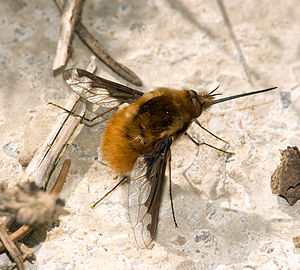Wollschweber
| Wollschweber | ||||||||||||
|---|---|---|---|---|---|---|---|---|---|---|---|---|

Large wool floater ( Bombylius major ) |
||||||||||||
| Systematics | ||||||||||||
|
||||||||||||
| Scientific name | ||||||||||||
| Bombyliidae | ||||||||||||
| Latreille , 1802 | ||||||||||||
| Subfamilies | ||||||||||||
|
The Wollschweber (Bombyliidae), also Trauerschweber , Bummelschweber or more rarely the funeral fly , are a family of the two-winged (Diptera) and are assigned to the flies (Brachycera). About 6000 species of this group are known worldwide, 34 of them in Germany.
Characteristics of the wool floater
The Wollschweber are mostly medium-sized flies that are conspicuous and hairy like bumblebees . Some of the species are dark in color and have black, translucent wings. This led to the alternative German name Trauerschweber . Some members of the group have a noticeably short or completely stunted trunk, while others have a very long trunk that is used to suck up nectar. In the species Bombylius medius , the trunk is almost as long as the body.
Way of life of the Wollschweber
Some types of woolen floats can be found as early as spring, but most do not appear until summer. They prefer open, sunny and sandy places. The animals are skilful and fast fliers who, like the hover flies (Syrphidae), also master the hovering flight . The hind legs are stretched back and up in flight, while the other legs point forward. The adults feed on nectar and flower pollen ; when they take in this food, the woolly floats often stand in flight in front of the flower and only support themselves with their front legs on the flower.
The partner is found in different ways. For example, both sexes meet at certain flowers or where the females lay eggs; some species also have pursuit flights in which the male chases the female. The eggs are laid either directly in the later hosts of the larvae and in their clutches, as is the case, for example, with the species of the genus Systoechus on egg clutches of grasshoppers , or in their vicinity. Some species can specifically shoot their eggs from flight, aiming in or close to the nest entrances of their hosts. These are often solitary wasps or bees . In this way, Spongostylum tripunctatum lays around 2000 to 3000 eggs per female, which it shoots on the nest of the black mortar bee ( Megachile parietina ). The larva later penetrates the nest through fine hairline cracks.
It is known of some species that they take up sand with their abdomen (the so-called sand chamber) before they actually lay their eggs and stick the eggs with it. The eggs are more protected from potential predators and the high temperatures on open sand surfaces. There are also two species of related predator flies that surround their eggs with sand.
Larval development

The larvae live as parasitoids on various other insects or on their larvae. The hosts are often species-specific, but the range can be quite large. Anthrax anthrax parasitizes various solitary bees, including mason bees , while other anthrax species parasitize grasshoppers or the caterpillars of owl butterflies . The Hemipenthes TYPES there is even a hyperparasitism in which the larvae, the eggs of parasitic parasitic wasps (Ichneumonidae, about Banchus - and Ophion TYPES) and of Tachinidae (Tachinidae, genus Ernestia erode). If the hemipenthes occur more than once , caterpillar plagues can sometimes be much more difficult to bring under control of course, since the caterpillars' parasitoids are missing.
The larvae change their appearance several times during their development ( polymetabolism ). The first larva is very agile and actively searches for a suitable host. It is equipped with 5 pairs of stub feet for this purpose. All later stages have no legs and accordingly have a typical maggot-like habit. In cases where the hosts are solitary bees or wasps, the larvae first eat the food for the host larvae before they attach themselves to them and eat them.
The overwintering usually takes place as a larva, before pupation these develop again a mobile pre-nymph stage. The pupa is also mobile and has thorns on the front end and bristles on the abdomen, with which it is easier to work out the ground nests of the hosts. The imaginal moult takes place outdoors.
The picture on the right shows the parasitization of a nesting board for mason bees.
Fossil evidence
The oldest fossil evidence of this family results from Cretaceous Siberian amber . Most species, however, have been described from tertiary deposits, particularly the Eocene Baltic amber . Some types are also known from the somewhat younger Dominican amber .
Types (selection)
- Large wool floater ( Bombylius major )
- Hottentot fly ( Villa hottentotta )
- Exoprosopa jacchus
- Anthrax anthrax
- Geron gibbosus
- Hemipenthes morio
- Lomatia lateralis
- Thyridanthrax perspicillaris
- Parageron incisus
gallery
Großer Wollschweber ( Bombylius major ) visits Silberblatt
Spotted woolen float ( Bombylius discolor ) in flight
Hottentot fly ( Villa hottentotta )
Individual evidence
- ↑ George O. Poinar, Jr .: Life in Amber . 350 pp., 147 figs., 10 plates, Stanford University Press, Stanford (Cal.) 1992. ISBN 0-8047-2001-0
- ↑ Wolfgang Weitschat and Wilfried Wichard: Atlas of plants and animals in Baltic amber , 256 p., Numerous. Fig., Pfeil-Verlag, Munich 1998. ISBN 3-931516-45-8
literature
- Joachim u. Hiroko Haupt: Flies and mosquitoes - observation, way of life. Naturbuch, Augsburg 1998, ISBN 3-89440-278-4
- Klaus Honomichl, Heiko Bellmann : Biology and ecology of insects. CD-ROM. Gustav Fischer, Stuttgart 1994, ISBN 3-437-25020-5
Web links
- Fam.Bombyliidae Hummelschweber, Wollschweber - bee flies ( Memento from June 20, 2008 in the Internet Archive )
- Bombyliidae (English)





